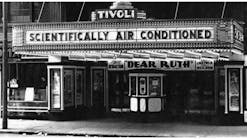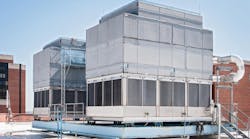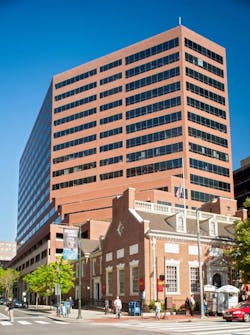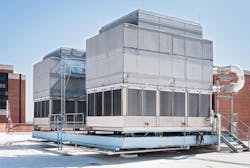At 615 Chestnut St. in Philadelphia, a 17-story, 380,000-sq-ft building housing private firms and government agencies, a restaurant, and a parking garage, the original water-source-heat-pump system generally functioned as originally intended, but a steady decline in energy performance and sharp increases in the cost of water were eroding the owners’—Seventh & Chestnut Associates and Waverly Management LLC’s—bottom line.
“Through the years, the loads in the building increased, and the old towers and boilers were having difficulty meeting the peak demand,” David B. Parmiter, PE, of Philadelphia-based Urban Engineers Inc. said.
According to Parmiter, the four original 250-ton forced-draft, closed-circuit cooling towers were consuming large amounts of water through evaporation. Also, even after several repairs and modifications to the coolers, the boilers were unable to maintain loop temperatures for cold morning start-ups.
“This resulted in compressors tripping off,” Parmiter said.
Parmiter explained that, over the years, the building’s original cast-iron atmospheric boilers lost efficiency and capacity. Their annual fuel-utilization efficiency had fallen far below early performance values. Combined with rising energy prices, this was causing operating costs to increase, despite efforts to curtail energy use.
“The challenge was to not just replace the equipment, but to improve performance while also reducing energy consumption,” Parmiter said. “The owners wanted to know what kind of payback would be seen with the energy-saving features we proposed, so we performed a comprehensive evaluation that included a return-on-investment calculation.
“The owners were concerned about the escalating cost of utilities, including domestic water,” Parmiter continued. “They also wanted us to help them understand all facets of the retrofit—everything from oversizing the (cooling) towers to optimizing (heat pump) compressor performance.”
Heat Pumps
By 2014, the old heating and cooling system had undergone many “patch” replacements, and most of the original water-source heat pumps had been replaced. According to Casey Younkins, PE, sales engineer with Kennett Square, Pa.-based equipment-manufacturers representative Energy Transfer Solutions, building managers gradually are replacing the remaining original heat pumps. By the spring of 2017, the replacement will be complete.
Game Changer
In August 2012, prior to starting the project, the owners made the decision to invest in the property by using technology that gave them the best return over the life of the equipment.
According to Younkins, the owners’ directive to the system design team was threefold: prioritize energy efficiency, minimize maintenance, and streamline water treatment.
“Being the original developer and long-term owners of the building, they asked us to explore ‘responsible’ ways to replace equipment,” Parmiter said.
The owners were most receptive to solutions that provided high-efficiency operation and long equipment life expectancy.
The facility engineer was using liquid-chemical water treatment, which required storage of water-treatment materials and germicidal chemical solutions in 50-gal. drums on the roof year-round, for the old evaporative coolers.
“We could offer a way to greatly simplify their water treatment (and water waste), although it bore a cost,” Younkins said. “The key to accomplishing it was a bit out of the owners’ comfort zone initially, but the solution—and the advantages of reducing maintenance and saving a large volume of water—was compelling.”
Intelligent Design
After careful review of the building’s needs and guided by the owners’ interests in a long-term solution, Parmiter recommended replacement of the forced-draft coolers with induced-draft closed-circuit coolers, controls to optimize operation of the entire mechanical system, and water treatment.
The owners appreciated the fact one company, Evapco Inc., could provide all three.
Parmiter and Younkins specified two eco-ATWB-E cooling towers, which would provide the most tower capacity while staying within the size and weight limitations of the existing support structure. The design included minor support modifications to allow the towers to be positioned with full-service platforms.
“The larger platform design is a big improvement,” Nick Jablokov, the facility’s chief operating engineer, said. “It gave us easy access to the equipment to allow routine maintenance without interrupting service.”
The new coolers would reduce the total connected fan-motor horsepower from 160 to 60, a 60-percent reduction in energy for the fans alone.
The savings were tied to Evapco’s spiral-finned-coil technology, coupled with Evapco’s Sage control system, which was designed for such installations.
Younkins said the coolers’ spiral fins add valuable heat-dispersing surface to the coils for both evaporative- and dry-cooling capability, significantly increasing thermal performance. Another advantage is that the new coils require a 40-percent-smaller footprint. This enabled the replacement of the facility’s four existing centrifugal-fan units with just the two eco-ATWB-E units.
To improve water and energy savings, the new coolers offer both evaporative and dry cooling simultaneously, as well as three modes of operation: evaporative, dry, and water-efficient (simultaneous wet/dry).
The technology’s simultaneous-wet/dry mode allows a portion of the heat load to be rejected through both evaporative cooling and dry cooling, even at high ambient temperatures, an operation mode that reduces water makeup, blowdown, and chemical consumption. Combined with Evapco’s non-chemical water treatment, facility managers were able to eliminate the use of chemicals for the coolers.
The owners followed Parmiter’s recommendation to convert to new fully modulating condensing boilers offering up to 96-percent operating efficiency.
“We were able to increase heating capacity, reduce emissions, lower operating costs, and complete the replacement within the existing footprint of the boiler room,” Parmiter said.
Smart Control
The control technology was developed to connect and manage all of the new system’s critical functions while also measuring and analyzing water inlet and outlet temperature with ambient dry-bulb monitoring.
“The control easily interfaces with BACnet, so the owner was able to seamlessly integrate the Sage control into their building automation system,” Younkins said.
The owners’ expectations for energy savings were exceeded when an energy analysis showed a dry-bulb switchover temperature of just under 60°F. That meant each unit would be able to operate in water-efficient mode for 48 percent of the year, reducing water consumption significantly.
Lastly, the owners chose to upgrade the cold-water basins to 304 stainless steel and include Evapco’s factory-mounted Pulse-Pure water-treatment system. Not only would this provide an environmentally responsible solution and eliminate the expense and drawbacks of chemicals, it would allow higher cycles of concentration, further reducing water consumption.
Two Years Later
Since the systems were installed in 2014, the owners have experienced significant cost savings through improved energy and water efficiency.
“There’s been fantastic improvement in system performance,” Jablokov said. “Engineering the right cooler size has allowed us to maintain an optimal 85-degree loop temp.”
Parmiter added, “We also discovered that connecting small air-conditioning units to the side of the fan-motor VFD (variable-frequency drive) enclosures—rather than using ventilation fans—made a huge improvement in protecting electronics from humid, dirty air.”
At the outset of construction, the owners were projected to save an average of 15,338 kWh per month, improvements equating to a 75-percent savings in total energy use and cost after one year. The owners also were projected to save an average of 96,260 gal. of water a month, resulting in a 24-percent savings in water use and cost after one year. When factored together, the owners would save an estimated $24,750 per year.
The Pulse-Pure water-treatment system, meanwhile, allowed the owners to eliminate the 50-gal. drums required by their previous liquid-chemical treatment system, as well as most of the maintenance required by the old technology.
Savings Realized
Thirty months after the retrofit was completed, Parmiter learned from managers of the facility, who had tracked energy/utility performance rigorously, that the systems had saved almost $25,000 a year in electrical costs alone.
The five years preceding the retrofit, 2009 to 2013, the building consumed an average of 631,000 kWh a month during the cooling season. In 2015, the first year after the tower replacement, that average dropped to 554,000 kWh a month, a 13.9-percent reduction in electricity consumed. The average cost of electricity is 9.6 cents per kilowatt-hour, so the savings average $7,400 a month during the cooling season.
To isolate the savings related to operation of the new cooling towers, the facility managers also ran calculations during the winter months (December, January, and February). The average electricity savings during the coldest months was 45,000 kWh, or $4,300, a month. The difference in savings per month, $3,100, can be attributed to the cooling towers. Over the eight months of cooling-tower operation, this amounted to about $24,800 in electricity savings.
Other significant savings were attributed to reduced water consumption. Building managers determined the average monthly reduction in water use during the cooling season was 180,500 gal. With the cost of water for the facility ($4.75 per hundred cubic feet, or $0.0064 per gallon), the average monthly reduction of the water bill was $1,155 during the cooling season. Projected over the eight months of tower operation, this amounts to an additional $9,241 in savings. There are additional savings for reduction in sewage fees, but those were not measured.
With these numbers, the savings that can be attributed to the new cooling towers average $4,255 per month during the cooling season, or $34,040 a year.
John Vastyan is president of Common Ground, a trade-communications firm based in Manheim, Pa.
For Design Solutions author guidelines, call Scott Arnold, executive editor, at 216-931-9980, or write to him at [email protected].











